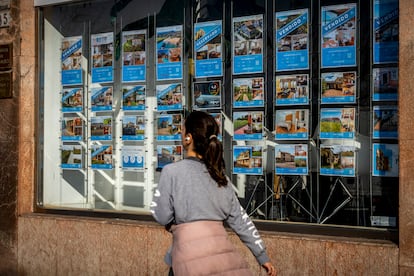Spaniards need almost 44,000 euros in savings on average to access a mortgage.


Housing prices in Spain are unstoppable—during the first quarter alone, they rose more than double that of the eurozone as a whole—so the bar for accessing a mortgage is increasingly higher. On average, a savings cushion of €43,902 is required to cover the down payment and the costs associated with the purchase and sale transaction. This means having saved almost 27% of the total price of the home, according to a study conducted by Qualis Credit Risk, an agent specializing in the underwriting and management of credit risk insurance for the insurance group AmTrust. Banks offer loans for up to 80% of the property's value, so it is necessary to have the remaining 20%, plus additional charges such as taxes, notary fees, and administrative fees, among others, which are not covered by banks.
This amount varies greatly between provinces. At the top of the list—well above the average—is the Balearic Islands, where a bank account of €78,779 is required to buy a home. Madrid and Barcelona, with €74,126 and €70,537, respectively, complete the podium. Followed by Guipúzcoa (€68,637) and Bizkaia (€58,521). On the other side of the scale, the provinces of Ciudad Real (€18,916), Jaén (€19,409), and Zamora (€20,655) stand out as those where the least effort is required to obtain a mortgage.
To arrive at these figures, Qualis Credit Risk used data on the average square meter cost up to the first quarter of 2025 from the Ministry of Housing and Urban Agenda. They also used 80-square-meter used homes as a reference, the most common type of house according to the National Institute of Statistics (INE). Furthermore, the Property Transfer Tax (ITP) was applied to the transaction's associated expenses—which only taxes the purchase and sale of a used home and varies depending on the region in which the property is located—and used BBVA's online mortgage simulator to add in additional expenses.
The authors point out that the high initial outlay drives solvent customers who lack sufficient savings or a family member to help them meet this expense out of the mortgage market. Jaime Marín, director of Qualis Credit Risk Spain and Portugal, points out that "there are thousands of potential buyers who, while financially solvent enough to cover the loan installments, lack sufficient savings to make the down payment." He adds that "all this unmet demand is relegated to the rental market , which in turn leads to an increase in rental prices in most Spanish cities."
In absolute terms, the housing price index—which has seen 44 consecutive quarters of year-on-year increases, i.e., 11 years of uninterrupted growth—stood at 171.296 points through March. Therefore, buying is 71% more expensive than a decade ago. Meanwhile, the appreciation in value for existing homes reached 66% over the same period.
For its part, the Youth Council revealed in its report , "A Problem Like a House," presented in January , that around 34.5% of those under 30 who live independently earn less than €1,000 net per month. This undermines their ability to save and access a mortgage—saving an average of €271.7 per month, after paying rent and other expenses. Only one in four young people who have left home is able to save more than €300. They also specified that nearly half of young people who have left home and own property report having needed help from others to get a mortgage. This entire situation could influence the high age of independence in Spain, which, according to the latest Eurostat data, stands at 30.4 years.
EL PAÍS

-U24273854127JKL-1024x512%40diario_abc.jpg&w=3840&q=100)



